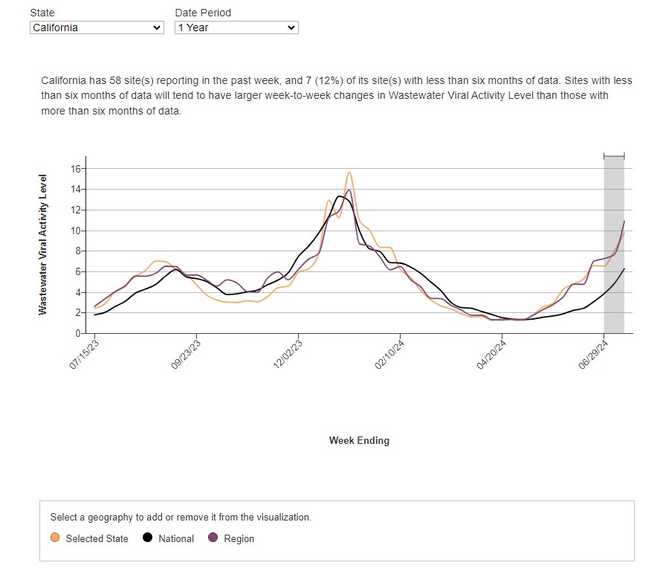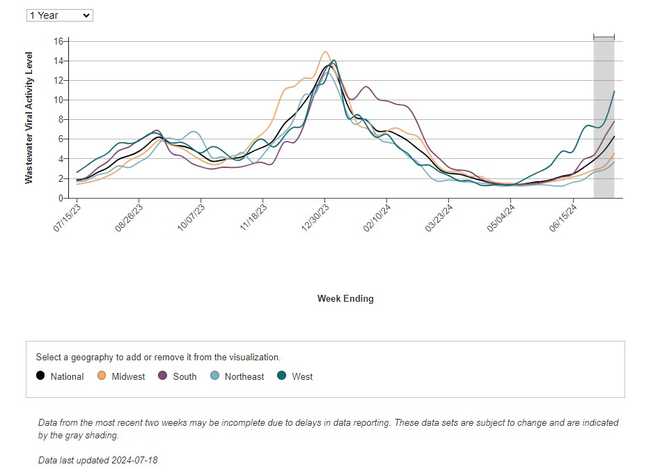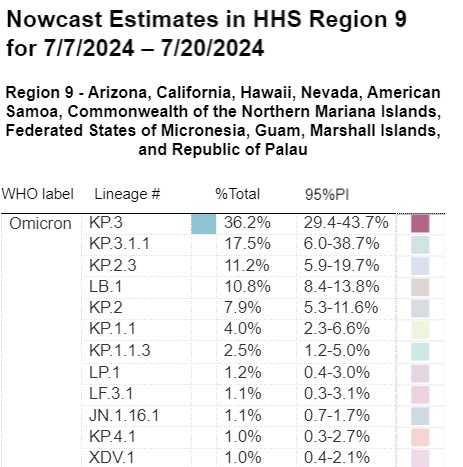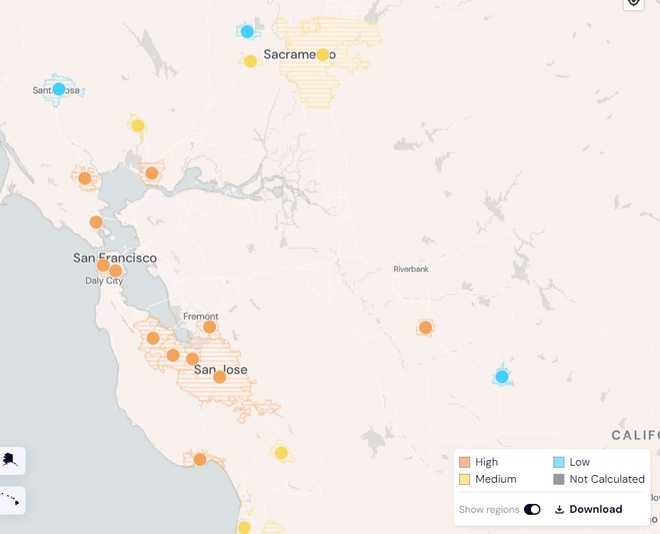2024-07-24 14:40:02
Wastewater testing is detecting “very high” levels of COVID-19 in California and other western states, according to a U.S. Centers for Disease Control and Prevention dashboard.As of July 18, the dashboard also shows very high levels for Oregon, Washington, Nevada, Utah, Wyoming, Colorado, New Mexico, Texas, Minnesota, Florida, North Carolina, West Virginia, Connecticut, New Hampshire, Vermont, Maryland, Alaska and Hawaii. (Video above: Pharmacists see increase in patients as COVID-19 cases rise in California.)The federal government no longer tracks COVID-19 levels but instead monitors wastewater levels as “an early warning that levels of infections may be increasing or decreasing,” according to the CDC.For the week ending on July 13, levels across the west were lower than they were last winter but greater than they were in July 2023. NBC News reported that summer travel and people staying indoors to escape the heat could be leading to more infections.Meanwhile, the latest information from the CDC shows the KP.3 variant as the dominant strain in the west and the country overall. KP.3 is reported to be a similar variant to the “FLiRT” variants KP. 1.1 and KP.2, which all descend from the dominant winter variant, JN.1. All are in the Omicron family, according to Prevention.com. Symptoms are said to be similar to those of past COVID-19 strains.”We’re seeing a lot of people coming in both for treatment and for vaccination and for testing,” Clint Hopkins, CEO of Pucci’s Pharmacy in East Sacramento, told KCRA 3 last week.Hopkins said he’s heard people are more sick with this new strain of COVID than they were in the past.Dr. Vanessa Walker, the chief medical executive for Sutter Roseville Medical Center, called the virus a “master masquerader.” “It just continues to find new ways to develop, new ways to evade the immune system,” she said. “And so as these new variants come out, they are just slightly different than previous strains. It’s harder for our body to fight them.”On Tuesday, Fresno County’s Department of Public Health cited “high” and increasing levels of COVID-19 in wastewater in the San Joaquin Valley. “Older adults and individuals with weakened immune systems are at greatest risk for hospitalization and death from COVID-19, and are strongly encouraged to get vaccinated,” the county said. “COVID-19 vaccines remain one of the most effective tools to reduce the spread of COVID-19 and prevent severe illness.”Sacramento County officials directed KCRA 3 to another dashboard that showed “medium” levels of COVID-19 in wastewater for the area. The same dashboard showed high levels in Turlock and across the Bay Area. The San Francisco Chronicle reported earlier this month that emergency rooms visits were rising in California but not at levels seen in past years.–KCRA 3’s Andres Valle contributed to this story.
Wastewater testing is detecting “very high” levels of COVID-19 in California and other western states, according to a U.S. Centers for Disease Control and Prevention dashboard.
As of July 18, the dashboard also shows very high levels for Oregon, Washington, Nevada, Utah, Wyoming, Colorado, New Mexico, Texas, Minnesota, Florida, North Carolina, West Virginia, Connecticut, New Hampshire, Vermont, Maryland, Alaska and Hawaii.
(Video above: Pharmacists see increase in patients as COVID-19 cases rise in California.)
The federal government no longer tracks COVID-19 levels but instead monitors wastewater levels as “an early warning that levels of infections may be increasing or decreasing,” according to the CDC.
For the week ending on July 13, levels across the west were lower than they were last winter but greater than they were in July 2023.
NBC News reported that summer travel and people staying indoors to escape the heat could be leading to more infections.
Meanwhile, the latest information from the CDC shows the KP.3 variant as the dominant strain in the west and the country overall.
KP.3 is reported to be a similar variant to the “FLiRT” variants KP. 1.1 and KP.2, which all descend from the dominant winter variant, JN.1. All are in the Omicron family, according to Prevention.com. Symptoms are said to be similar to those of past COVID-19 strains.
“We’re seeing a lot of people coming in both for treatment and for vaccination and for testing,” Clint Hopkins, CEO of Pucci’s Pharmacy in East Sacramento, told KCRA 3 last week.
Hopkins said he’s heard people are more sick with this new strain of COVID than they were in the past.
Dr. Vanessa Walker, the chief medical executive for Sutter Roseville Medical Center, called the virus a “master masquerader.”
“It just continues to find new ways to develop, new ways to evade the immune system,” she said. “And so as these new variants come out, they are just slightly different than previous strains. It’s harder for our body to fight them.”
On Tuesday, Fresno County’s Department of Public Health cited “high” and increasing levels of COVID-19 in wastewater in the San Joaquin Valley.
“Older adults and individuals with weakened immune systems are at greatest risk for hospitalization and death from COVID-19, and are strongly encouraged to get vaccinated,” the county said. “COVID-19 vaccines remain one of the most effective tools to reduce the spread of COVID-19 and prevent severe illness.”
Sacramento County officials directed KCRA 3 to another dashboard that showed “medium” levels of COVID-19 in wastewater for the area. The same dashboard showed high levels in Turlock and across the Bay Area.
The San Francisco Chronicle reported earlier this month that emergency rooms visits were rising in California but not at levels seen in past years.
–KCRA 3’s Andres Valle contributed to this story.








